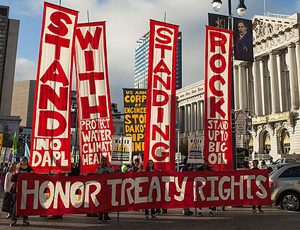The Standing Rock protests over the Dakota Access pipeline last year brought Native American activism into sharp focus. But the Native American community has fought for civil rights for decades.
CPL kicks off Native American Heritage Month with Native Americans Speak Out!: The Return of Navajo Boy Film Screening on November 4 at Lozano Branch. This documentary is about a long-lost family member who becomes an activist when uranium contamination threatens his home.
Want to learn more? Here are other stories of activism in the Native American community.
Historically, the Native American population of Chicago has always fought for change. City Indian describes how in the early 20th century, leaders of the community banded together and stood up to Mayor "Big Bill" Thompson to ensure that public schools here taught about "First Americans." They also created the American Indian Center, which hosts events and classes.
You Are on Indian Land! tells how Native American activists took over Alcatraz Island for 19 months in the late 1960s. Their goal was to establish an Indian cultural center and school. Eventually, the island housed a temporary clinic, cafeteria, school and security force. Even though the occupation ended not long after the death of one of the organizer's daughters, the effort inspired other occupations and protests across the country.
In the 1940s, government scientists discovered uranium on a Navajo reservation. Native Americans were forced to work unprotected in the mines, and the element seeped into every facet of their life, contaminating the water and the land. The people in the reservation are still dealing with the fallout today. These activists are fighting for environmental justice, working to stop the mining that still goes on today. Read more about this struggle in Yellow Dirt.
Native American activism is not just happening in the past. In This Indian Country, the author explores Native American political activism, then and now.




Add a comment to: Native American Activism, Past and Present